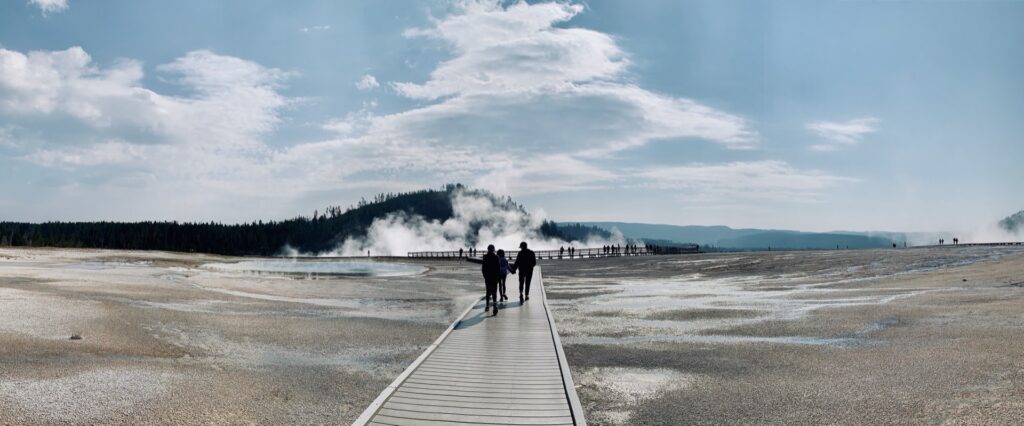Yellowstone National Park has to be one of the strangest and most beautiful natural parks in the world. Since we homeschool, we were able to visit after peak season (late August, 2021), allowing us to avoid the crowds and have some truly magical moments. There’s a LOT to cover, so let’s jump in!
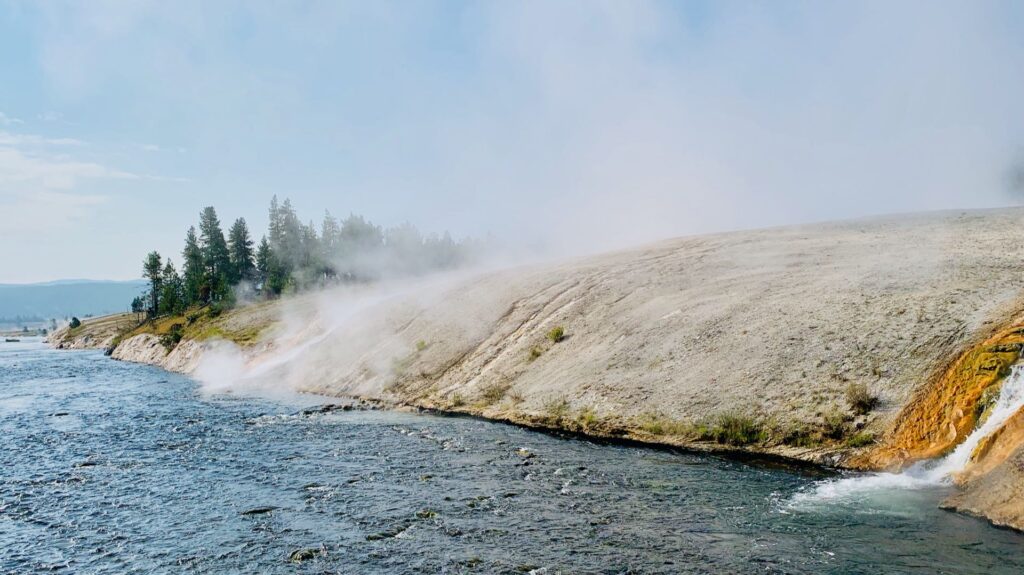
What to know before you visit
A trip to Yellowstone will be much more enjoyable if you plan ahead. So, here are some things to know before you go.
🗺️ It’s big. Really big.
First, Yellowstone is HUGE. At 2.2 million acres (3,472 square miles / 8,992 square kilometers), the park covers an area roughly the size of Puerto Rico and could fit around 23 JFK International Airports inside the park boundaries. It’s also one of the most diverse ecosystems in the world featuring over 10,000 geothermal features (500 of them being geysers), 67 species of animals (including grizzly bears, wolves and bison) and 900 miles of hiking trails.
With over 900 miles of hiking trails, each of it’s over 2 million acres is its own destination.

Pro Tip: Download and purchase a GPS guide through GuideAlong. There’s a guide for Yellowstone that includes 375+ points of interest, and there’s also a version that includes Grand Teton with 550+ points of interest.
🗓️ Reserve well in advance
Peak season is from late May through Late August. Campgrounds fill up quickly and you will need to search online at least six months in advance, if not a year or more. If you have trouble finding something that fits your unique situation, or have questions about each campground, call the park. Their rangers know all the options and may even be able to reserve things that aren’t available online.
😧 You literally can’t see it all
If you go, you will definitely feel some FOMO because you simply cannot see everything the park has to offer. There’s just too much. There may be some scientists and people with special permits who have seen a lot more than most people, but they are the exception. No one actually lives in Yellowstone full-time unless you count bears, rangers, or the occasional scientist sleeping on a cot next to a seismograph.
🥪 Plan your meals + snacks
Our food situation was complicated because we stayed in a pop-up camper and spent the first four days in Grand Teton National Park. However, even a day or two at the park needs some level of planning. Bring a good cooler, plan where you get ice, and prepare for lines at restaurants during busy times.
🛑 rules & advisories
Yellowstone, like any major park, changes day-to-day. Weather, wildlife and other factors pop up frequently so check their website before and during your stay. Their site includes information on closures, construction, geothermal events and wildlife encounters. It also has a list of rules and recommendations for a safe, enjoyable experience.
What you can expect to see
From the moment you enter the park, you will feel like you’re on another planet. As you drive to the gate and beyond, you’ll start seeing (and smelling) some geothermal activity and may even see some wildlife. Just keep looking around, and don’t forget to mind the speed limit.
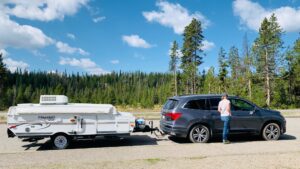
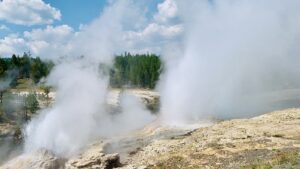
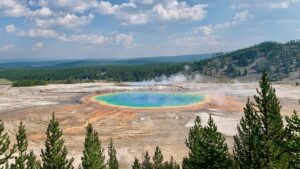
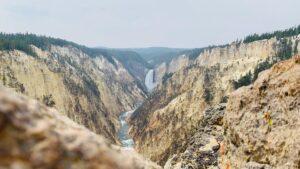
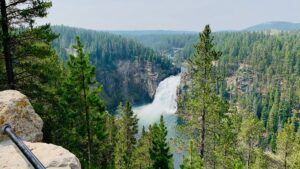
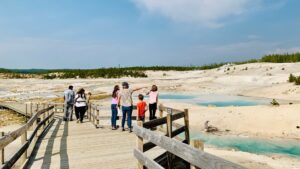
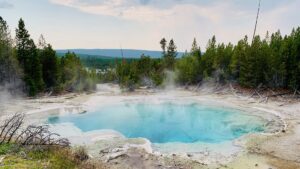

Lodging and Camping in Yellowstone
Yellowstone features 12 campgrounds (over 2,000 individual campsites), and nine main lodges, but with over 4.5 million visitors per year, you’ll want to book ahead at least 6-12 months in advance. How do you book? Many campsites can be booked online at recreation.gov, but keep in mind that many of the lodging and campground options are managed by a third-party (Xanterra) which has a separate booking system.
When we booked our site at the Grant Village Campground, we spent a lot of time navigating the website and looking for spots to open up that matched our camper size (our popup is 16 feet long, 20 when fully popped up). We eventually had to call and the park ranger helped us find a spot that wasn’t listed on the site, or at least wasn’t listed correctly. It was actually a relief to chat with a real human and get confirmation from them versus relying on the website.
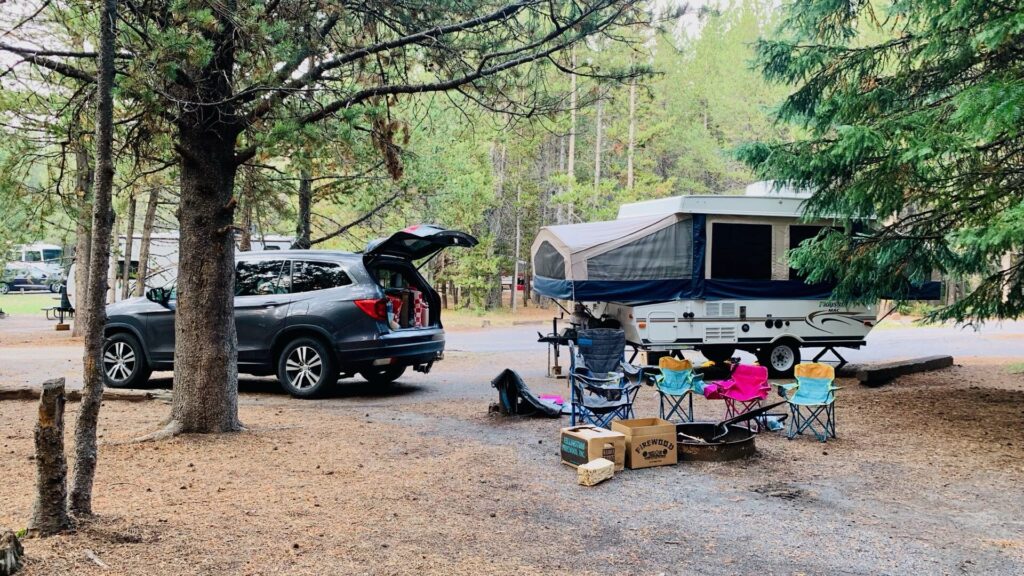
The campground was pretty basic, but it was on par with other National Park campgrounds. It included a picnic table, fire ring and bear locker which we stored our non-perishables and cooking equipment in. There were bathrooms within walking distance of our site (and they were heated!) and attached to the bathroom building was a small room with a large sink where we washed our pans.
The only thing we didn’t love about the site was the use of generators around us. You’ll be mixed with some larger RVs which need power and since there are no hookups, they use generators between 8AM and 8PM. Also keep in mind that some campground have restrictions on the type of camper you can bring: some are tent-only, while others require RVs to be “hard-sided” to prevent bear break-ins.
Our Five Day Itinerary
We visited Yellowstone in late August, 2021 and spent three full days there. We know we missed a lot of things, but we developed a strategy that we felt worked pretty well for us: plan your days around bigger landmarks, but leave room to stop along the way.
Here are a few of the landmarks we visited during our five-day (really three and a half full days) stay:
Day one – Exploring near our campground
- West Thumb: An easy introduction to the park if you are camping nearby. West Thumb is a volcanic “thumb” off Yellowstone Lake formed ~174,000 years ago and features a boardwalk through geysers, hot springs, mud pots and deep pools like Abyss and Black Pool. Don’t forget to see “the “Fishing Cone” which is a small heated pool just off the shore where early explorers used to cook their fish (or so they say).
- Pumice Point: Not really a major attraction but Pumice Point is a relaxing area on the shore of Yellowstone lake. No facilities, but scout the shoreline for pieces of real pumice!
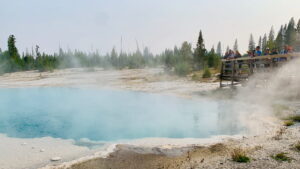
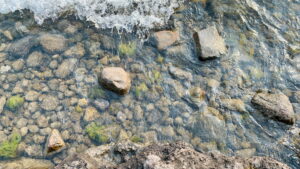
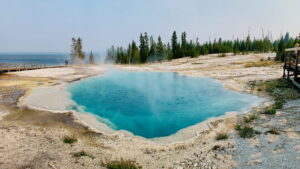
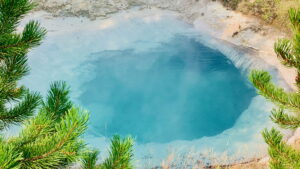
Day two – Mammoth Hot Springs
- Continental Divide: Grab a photo here, but don’t plan on staying very long. It’s just a quick roadside stop that reminds you you’re straddling two massive watersheds. Water to the west flows to the Pacific, and to the east, the Atlantic.
- Lower Geyser Basin Trail: An easy walk through a large geothermal area with bubbling mud pots, steaming vents, and random eruptions. Less crowded than Old Faithful but still active. We ventured here early in the morning which offered a uniquely steamy/foggy view of the area.
- Gibbon Falls Trail: A short, paved trail along the Gibbon River with a great view of the 84-foot waterfall. Easy access, decent photo op, and a nice spot to stretch your legs between bigger stops. We didn’t stay very long, but it was an inspiring point to witness the power of water.
- Beryl Spring: Another short stop that’s right off the road, Beryl Spring is a boiling pool of beautiful turquoise water. We smelled it before we saw it.
- Mammoth Hot Springs: We stopped by Fort Yellowstone and then went to Mammoth Hot Springs. This area is unique in due to how the water flows from under the earth, bubbling up to flow down terraced limestone formations that look like they’re melting.
- Norris Geyser Basin: This is one of the most active geothermal spots in the park. Be sure to pay Vixen Geyser a visit. Just wait a few minutes as the water rises, bubbles form, a small eruption happens and then it all drains away (creating a familiar and fun sound). The whole area place smells like sulfur and sounds like it’s alive. There’s a LOT to see here, so pace yourself.
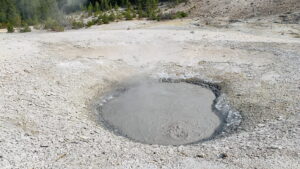
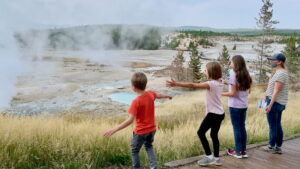
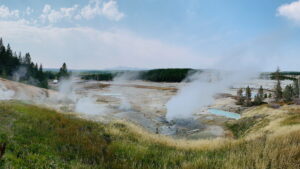
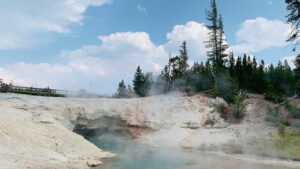
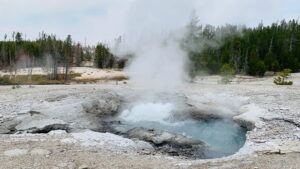
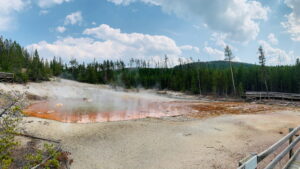
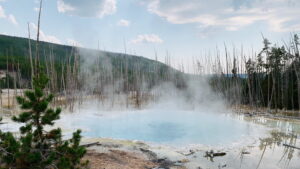
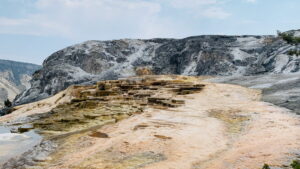
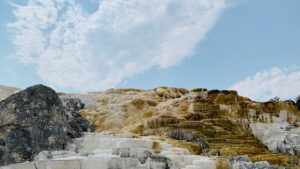
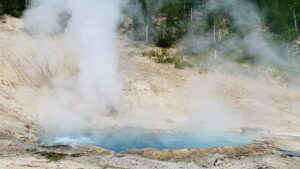
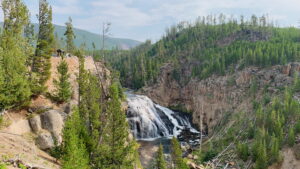
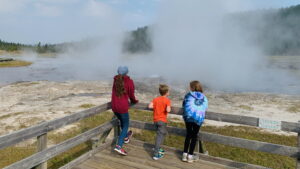
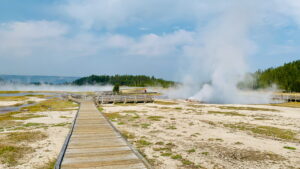
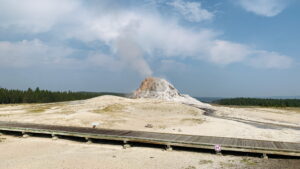
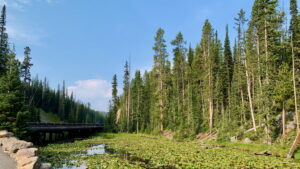
Day Three – Artist Point and Old Faithful
- Lake Yellowstone Hotel: We weren’t initially planning to stop here, but we were glad we did. The Lake Yellowstone Hotel is a classic, bright yellow hotel right on the lake and is the oldest operating hotel in the park (since 1891). The lobby and lake views are worth a quick visit.
- Mud Volcano Trail: This trail is a short loop with many bubbling mud pots, and hissing vents to look at. It also features a steamy cave called Dragon’s Mouth Spring which is by far the smelliest of all the features we saw in Yellowstone (be prepared!).
- Hayden Valley / Bison along Yellowstone River: If there’s one place in Yellowstone where you’re almost (almost) guaranteed a view of some bison, it’s Hayden Valley. They’re known for blocking the road in this area, but we found them grazing, napping and playing in the grass a couple hundred feet away and easily found a place to pull off for a few minutes. Pro tip: avoid death or injury and enjoy viewing these giant beasts from a safe distance.
- Lower Falls Overlook: These falls are massive. The Lower Falls features 308-foot waterfall in what’s known as the “Grand Canyon of Yellowstone.” There are multiple viewpoints, but this one gives you that classic head-on shot. We stopped here for lunch and enjoyed the distant sound of the falls.
- Artist Point Overlook: This area will be crowded, but if you have limited time and want to witness one of the more picturesque views in the park, this is your spot. It’s really amazing to see in person.
- Artist’s Paintpots Trailhead: Another short loop through a geothermal area with boiling mud and bright-colored pools. Some are more beautiful than others, but it’s an easy hike (with a little elevation gain), that’s not usually busy. A lot of weird quirks of geothermal activity can be found in this area.
- Firehole Canyon Road: This is a beautiful, winding, one-way road – just off of the main road – that follows the Firehole River. There’s supposedly a warm swimming area you can hike down to but it was closed when we visited. If you have the time, it’s a nice alternative route.
- Old Faithful: You can’t go to Yellowstone National Park and NOT see Old Faithful. Check the schedules in the ranger station for the most up to date prediction for when the next eruption will be. It’s usually about 90 minutes between eruptions, but it varies quite a bit. That’s just how nature works. There is a LOT to see in the area, so we actually just came to see Old Faithful and came back the next day to explore the rest of the area.
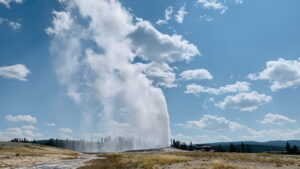

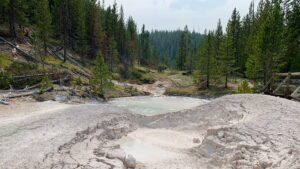
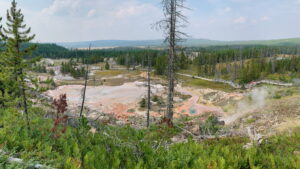
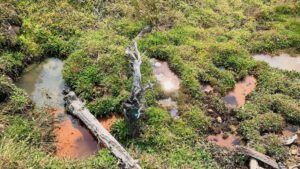
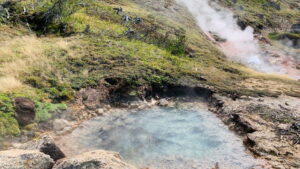
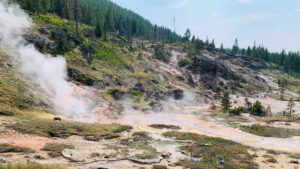
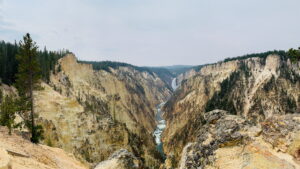
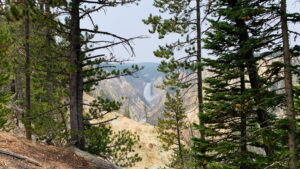
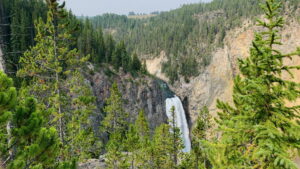
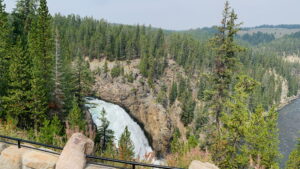
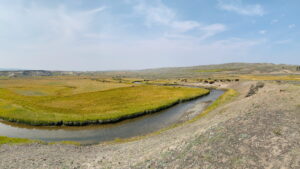
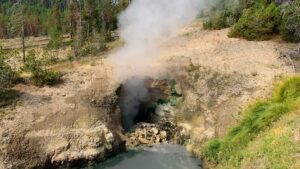
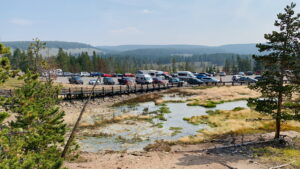
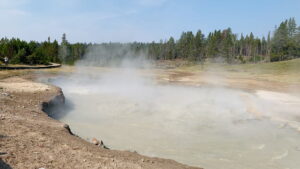
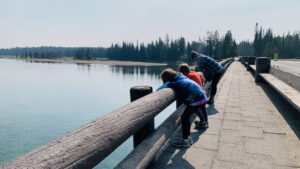
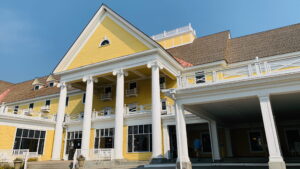
Day Four – Grand Prismatic
- Midway Geyser Basin: Just up the road from Old Faithful is Midway Geyser Basin – a compact boardwalk loop with some of the park’s most vivid thermal features. Grand Prismatic Spring is the star and you can walk all the way around it which provides a sense of the immense scale of the feature.
- Grand Prismatic Overlook Trail: For an alternative view of Grand Prismatic, I suggest you walk up to the Grand Prismatic Overlook. If you hike around Grand Prismatic first, you’ll have a new appreciation for how big the pool is when you reach the overlook. Parking can be a little challenging, but just be patient. People come and go quite frequently so a spot will open up eventually.
- Old Faithful Inn: This is a rustic lodge built in 1904 that’s made almost entirely of logs and stone. When you step inside it feels like you’re entering a giant indoor treehouse that was built by some skilled pioneers. Even if you’re not staying there, the lobby is worth wandering through.
- Upper Geyser Basin Trail: This is the trail system behind Old Faithful that leads to many other geysers and hot springs. It’s less crowded than the main eruption area and has more varied geothermal features. Great for an early morning or evening stroll.
- Biscuit Basin Trail: This short loop is a little further away from the upper geyser trail system but is connected via paved trails. Like many areas of the park, it features bright blue pools, steaming vents, and occasionally erupting geysers.
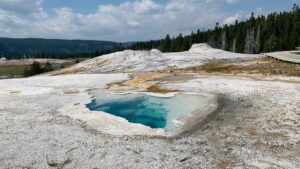
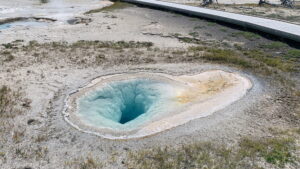
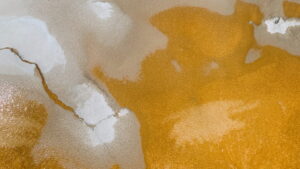
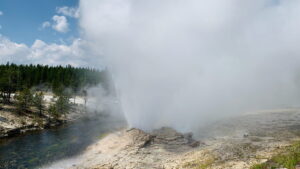

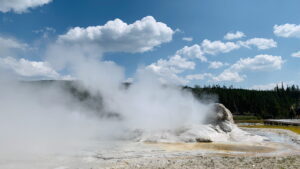
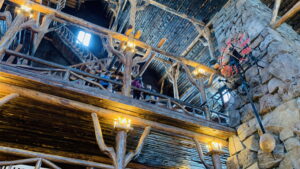
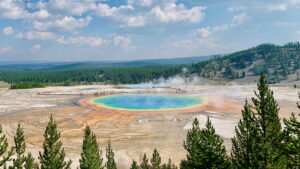
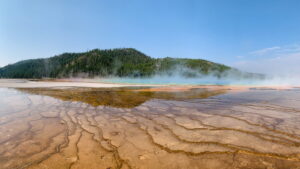

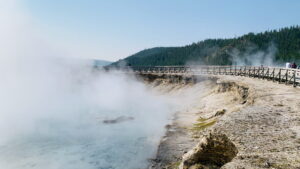
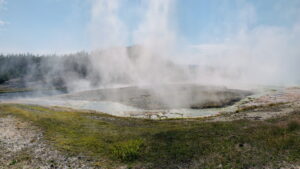
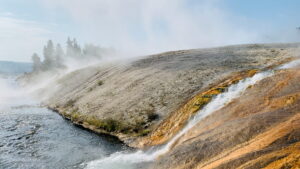
One more thing about Biscuit Basin – this area is also where one of our most memorable moments from our entire trip happened: Fan Geyser. We were about 100 meters from where the walkway crosses the Firehole River, and we heard lots of cheering and commotion. As we walked closer, there were cheers from the growing crowd. Then, right as we caught a glimpse of Fan Geyser, it started erupting… and it kept erupting for a solid 10 minutes! Apparently, this is a very rare event and we just happened to be in the right place at the right time.
Educational opportunities in Yellowstone
There are so many educational opportunities in Yellowstone. Whether you’re listening to a Guidealong Tour, booking a private tour or just taking some time to read the signage in the park, there is something to learn for all ages. We relied heavily on our Guidealong Tour for this trip because the narrator (we called him “Parker Moose Jackson”) was easy to follow, funny and full of interesting facts and stories.
Don’t hesitate to ask the rangers all of your questions too! They live for this kind of thing and are happy to share what they know even if you’re the four-millionth person to ask the same question in the same year.
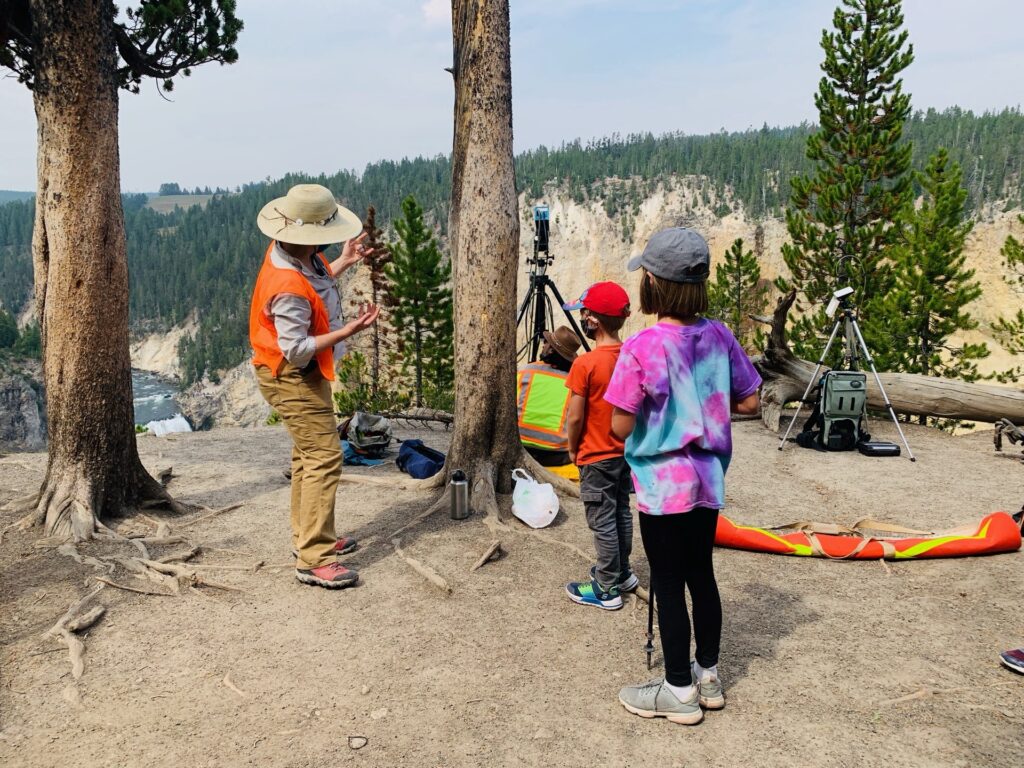
One of the more interesting conversations we had was with some researchers who were doing a geological survey. These scientists stay at the park for weeks or sometimes months at a time, and often bring specialized equipment with them. While we were visiting Artist Point, we met a scientist who was measuring the walls of the canyon with a laser to see how they had moved, grown and shifted over time. It was really interesting to see, and she was very eager to share her process with the kids.
Our thoughts on Yellowstone
Yellowstone is a must-see National Park that offers so many amazing experiences. From the wildlife, to the geothermal features to the history of the park, there is a lot to learn, see and do. We wish we could have stayed longer, but we were thankful to be able to pack so much into those full three days.
As long you’re prepared, you’ll have an amazing time. Start planning NOW!
But what about… bears?
Ahh, right. Almost forgot. The question everyone asks: what about… bears?
Yes. There are bears in Yellowstone National Park. The black kind (that just want your food) and the brown kind (that might decide you are food). For both types of bear you need to be smart and follow the bear advice on the Yellowstone National Park website.
When we visited the park, Meredith and I both packed a can of bear spray and had it accessible when we were in areas with few people. A few rules we never broke: don’t leave food out, don’t hike with meats and open snacks, make noise while hiking (easy for our big family), and don’t venture into backcountry trails. We never did see a grizzly bear, but we did see a few black bears during our trip.
Talk to the rangers, follow the rules, and use common sense and you’ll be just fine.

